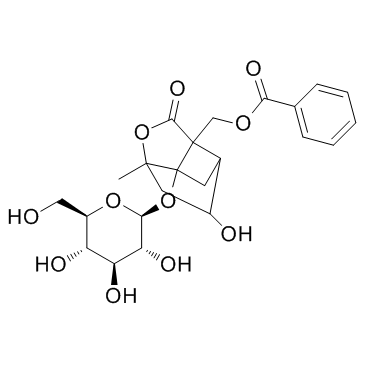39011-90-0
| Name | Albiflorin |
|---|---|
| Synonyms |
7-Oxatricyclo[4.3.0.0]nonan-8-one, 9-[(benzoyloxy)methyl]-1-(β-D-glucopyranosyloxy)-4-hydroxy-6-methyl-, (1R,3R,4R,6S,9S)-
[(1R,3R,4R,6S,9S)-1-(β-D-Glucopyranosyloxy)-4-hydroxy-6-methyl-8-oxo-7-oxatricyclo[4.3.0.0]non-9-yl]methyl benzoate Paeonia lactiflora Pall. Alibiflorin albiflorin |
| Description | Albiflorin is a major constituent contained in peony root; possesses therapeutic potential for neurodegenerative diseases.IC50 value:Target: in vitro: Albiflorin significantly ameliorated Glu-induced reduction of cell viability, nuclear and mitochondrial apoptotic alteration, reactive oxygen species accumulation, and B-cell lymphoma 2 (Bcl-2)/Bax ratio. Albiflorin also enhanced phosphorylation of AKT and its downstream element glycogen synthase kinase-3β, and this effect was abrogated by the AKT inhibitor LY294002 [1]. in vivo: Mice were exposed to X-ray radiation (400 Roentgen), and both mice and rabbits were intraperitoneally injected with cyclophosphamide (100.0 mg/kg) and cytarabine chloride (92.7 mg/kg), respectively, for 3 days to induce myelosuppression. Albiflorin was subsequently administrated intravenously at low (15.0 mg/kg for mice, 6.00 mg/kg for rabbits), intermediate (30.0 mg/kg for mice, 12.0 mg/kg for rabbits) and high (60.0 mg/kg for mice, 24.0 mg/kg for rabbits) doses, as well as orally (60.0 mg/kg for mice, 24.0 mg/kg for rabbits) for 7 days. Shenqi tablets were used as positive controls (oral administration of 936.0 mg/kg for mice, 336.0 mg/kg for rabbits). The administration of Albiflorin significantly ameliorated myelosuppression in all cases [2]. |
|---|---|
| Related Catalog | |
| References |
| Density | 1.6±0.1 g/cm3 |
|---|---|
| Boiling Point | 722.1±60.0 °C at 760 mmHg |
| Molecular Formula | C23H28O11 |
| Molecular Weight | 480.462 |
| Flash Point | 248.9±26.4 °C |
| Exact Mass | 480.163147 |
| PSA | 172.21000 |
| LogP | -0.97 |
| Vapour Pressure | 0.0±2.5 mmHg at 25°C |
| Index of Refraction | 1.662 |
| Storage condition | ?20°C |
| Safety Phrases | 24/25 |
|---|---|
| RIDADR | NONH for all modes of transport |


